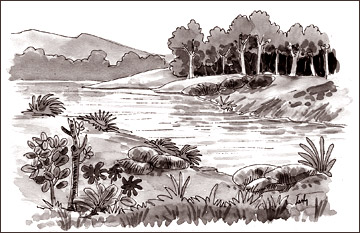By the banks of the Mahaweli
Donald Nugawela
Shortly after the rains had stopped pounding the Mahaweli early
January and the muddied waters had turned clear I walked along the
Gannoruwa side of the great river. I was in search of the seventeenth
century battle-field and to relive the fierce encounter between the
Sinhalese army led by King Rajasinha II and the Portuguese in 1638 and
where the Portuguese were simply decimated in a great guerilla style
operation. It is now known to History as the Battle of Gannoruwa.
To this end I was accompanied by Dingiribanda, aka Bande and Bandaiya
to lesser mortals. Bande was an ageless wonder and was Man Friday to a
relative who loaned him for a few hours to show me around the nooks and
crannies of Gannoruwa. Bande was best suited for this small expedition,
being a sturdy son of the soil. Born and bred at Gannoruwa his entire
world revolved by the banks of the Mahaweli. It was also his proud boast
that his ancestors formed a part of the army which massacred the
Portuguese. Folklore and family lore embellished with the passage of
time by the few original families whose ancestors had fought for king
and country in those ancient times were not many. I met a few of them
and they were in a minority with settlers more in the majority, and with
warring battles and history all buried under modern Gannoruwa.

Bande led me safely along the banks where the soil was yet soft and
which squelched under foot following the recent rains. We came to a
small bend and sat on two dry rocks overlooking the swiftly flowing
waters. Across the river was the Peradeniya Botanical Gardens, looking
neat and tidy and to the far right was the centuries old Peradeniya
bridge which has withstood many a monsoonal storm. On the far background
was the now elegant Gannoruwa highway and further away the old and
familiar agricultural research stations that has been contributing so
much towards the nations agricultural needs.
Seated on the rock with the sun on my back I watched Bande going
through the motions of preparing his chew of betel. He took time over
assembling the betel, areca, tobacco and lime, which to me seemed very
elaborate. How many times had I seen our peasants putting together their
chew which for me always seemed a near divine ritual practised by them.
And so did Bande on this day as I sat patiently and in silence for the
ritual to end. He folded the betel into a small packet and deposited it
in his mouth and I strained my ears to hear the crunch of areca and for
the grunts of delight as he ejected the inevitable red spittle with
unerring aim at a chosen spot. He was ready to take me back and unfold
the battle fought in the wild terrains of Gannoruwa several centuries
ago. His account as told by his ancestors and passed down from
generation to generations of true blue Gannoruwans is as follows.
When spies brought the frightening news that a large army headed by
the Portuguese was converging on the Kandyan Kingdom there was near
panic. King Rajasinha immediately gathered his army together but being
short of manpower, Criers were sent out to all parts of the kingdom
calling on the people to come forward in defence of their country. The
response was magnificent. They came in their hundreds, from Thumpane,
Harispattuwa, Dumbara, Yatinuwara and Udunuwara and they flocked to
Senkadagala in defence of their king and country.
They had left behind their agricultural pursuits, their homesteads
and loved ones to fight for their honour and for all that was dear to
them.
They came armed with primitive weapons. Bows and arrows, swords,
katties and sharpened staves. They massed on the banks of the Mahaweli
and took up positions in the thick jungle, under large boulders, on
trees and on every available space.
They waited patiently and in silence until the last enemy soldier had
walked into the trap. The enemy was unaware that a large force had
encircled them and that there was no escape for them. When the first
long hoot pierced the thick jungle canopy they descended on the hapless
Portuguese. The Portuguese did not fire their muskets and cannon in
their defence as the surprise was complete. They were massacred to a man
and those who tried to escape were pursued and killed with bare hands.
Such was the intensity and fury of the Sinhalese soldiers.
Bande seemed animated when he concluded his grim account. He stood up
eyes aflame and spreading his arms wide as if to encompass the entire
modern Gannoruwa told me that the area was one large battlefield and
that there were no graves to mark any burial spot and no enemy was ever
buried in Gannowuwa.
Their graves was the Mahaweli which on that day was a river of blood
and what mattered he said was that the over-confident Portuguese were
taught a lasting lesson and they never did attempt to invade Senkadagala
thereafter.
My urge to capture the past sated, I reflected that Age had left us
two silent witnesses to that carnage. The jungle now reduced to a
Reserve rich in Fauna and Flora and the banks of the Mahaweli soaked in
blood and gore and where much of it had been carried away swiftly by the
river on its long and lonely journey to the sea. |



